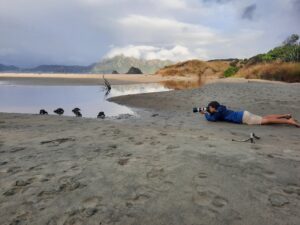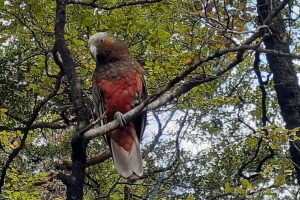The 793ha Hadfield Clearing was bought into the Abel Tasman National Park in 2003/4. Restoration efforts were focused on a 25ha paddock which was then covered in rank grass with gorse moving in and the remnants of farm buildings and old fences still standing. Restoration work involved battling against browsing hares and frosty winters to get plants to a point where they could survive.
Helen Lindsay started working with Project Janszoon in 2013, creating a restoration plan for Hadfield’s Clearing. Since 2016 she has been an integral part of the Janszoon team, with responsibility for projects like Firesmart, rata restoration, the beech seedling trial on Adele Island, and the ongoing restoration and management of Hadfield Clearing.
“Hadfield Clearing obviously needed help,” says Helen, “but it also included one of the largest remnant stands of kahikatea swamp forest in the Nelson-Tasman region, so we aimed to assist in bringing the swamp forest back into the clearing which had been drained in the past for farming purposes.”
The first step was to remove the gorse, and then planting started in 2014.
“We began with flax, manuka and swamp coprosma,” said Helen, “to mimic the natural regeneration process.”
But the first few years were tough, with Hadfield being one of the coldest places in the park due to its low-lying topography which creates a natural frost pocket.
“As well as hoar frosts, the young trees had to contend with hares, deer and goats,” said Helen. “The coprosma could handle the frosts but the hares loved eating it!”
Plant survival was patchy in the first few years. Hare control on site as well as the reduction of deer and goats in the park has made a big difference to later plantings, and there were lessons learned about how to plant manuka in these conditions to maximise survival.
“In the end we decided it was better to plant fewer trees and focus on getting the survival rates up, which meant that we would be slower getting the initial cover established but it was the only way, and it has worked out OK.”
One of the big discoveries was that kahikatea trees could survive the conditions even without side shelter.
“We had ordered 3000 kahikatea trees thinking we’d be ready to plant them in year 4. We had to hold them back as we weren’t ready, and thanks to the hard work of the volunteers in the DOC community nursery, repotting them as they grew, they were 2m tall by the time they were finally planted,” said Helen.
“The side shelter was not as high as we would have liked but they did really well – that year we had 65% survival of kahikatea against 25% survival rates for manuka. So we have continued to plant a few each year – when they are 2m tall they have their heads out of the worst of the low lying frosts which helps them to survive.”
As the restoration progresses, natural regeneration is starting to contribute to the picture, and ongoing hare control is helping young seedlings to establish.
The planting and weeding will continue for the foreseeable future but now that the weeds and hares are being controlled, the future looks promising for a return to the original swamp forest ecosystem that once dominated this area of the park.
Hadfield Clearing was named for the Hadfield family, who farmed at Awaroa for many years.
The history of the site can be found on our website and on page 230 of Philip Simpson’s book, Down The Bay.



